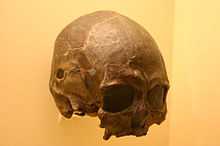Tepexpan man

The Tepexpan Man is a Pre-Columbian era skeleton, discovered by archaeologist Helmut de Terra in February 1947, on the shores of the former Lake Texcoco in central Mexico.[1] The skeleton was found near mammoth remains and thought to be at least 10,000 years old.[2] It was fancifully hailed by Time magazine as the oldest Mexican Soldier.[1]
From 23 August 2007 until the end of 2008 the National Institute for Anthropology and History (INAH) of the State of Mexico paid homage to Helmut de Terra and his life and times, especially related to his work in Mexico in the late 1940s and early 1950s. This exhibition was at the Tepexpan Museum built over the site of the 1947 discovery.
In 2009 a research team proposed that the skeleton should be dated at about 4,700 years old, based on uranium geochronology.[2]
Based on DNA analysis, a Mexican archaeologist has proposed that Tepexpan 'man' was actually a woman.[3]
See also
References
- ↑ 1.0 1.1 "Science: American Face". Time. 20 October 1947. Retrieved 2010-04-01.
- ↑ 2.0 2.1 "Isotope analysis dates ancient Mexican". Planet Earth online. 14 July 2009. Retrieved 2010-04-01.
- ↑ Weber, George (1 January 2007). "Tepexpan Woman (Mexico State, Mexico)". George Weber's Lonely Islands. Retrieved 25 January 2011.
The skeleton including skull of what was named Tepexpan "man" was found in May 1946 and was first thought to be the skull of a man. On later analysis it turned out to be a woman.